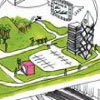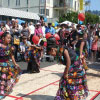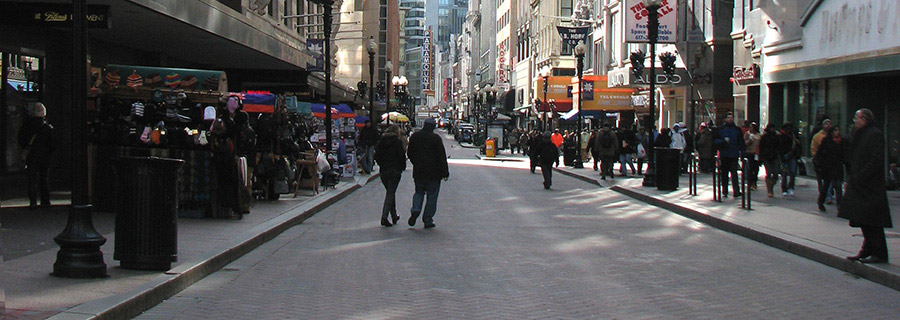
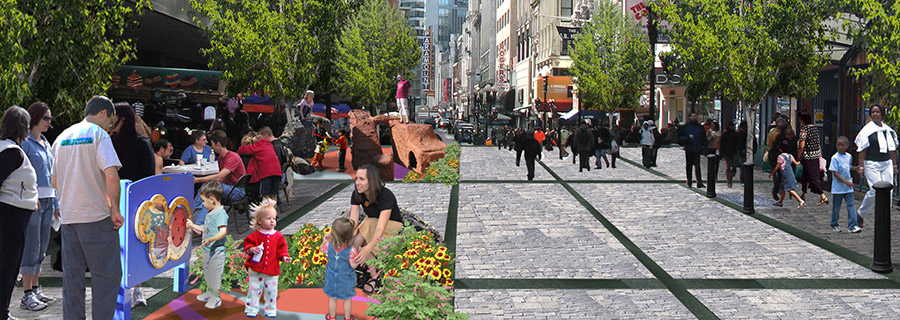

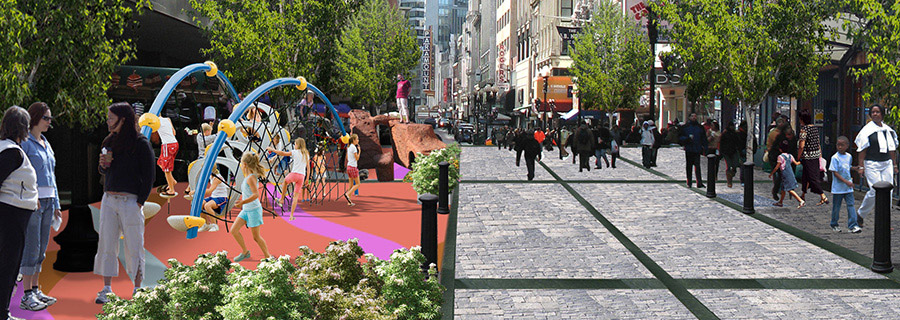
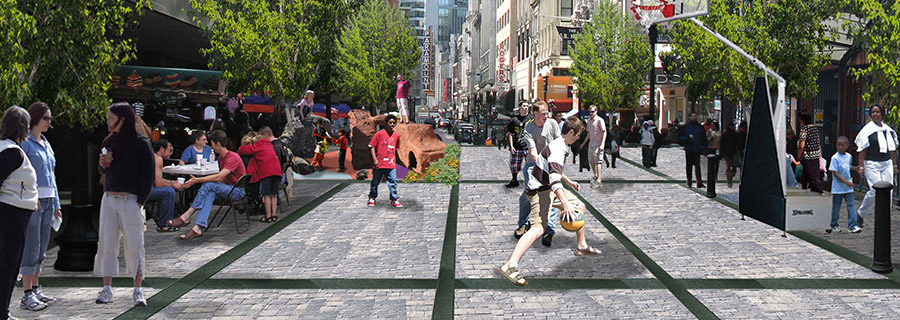
Play may be defined as active and passive recreational activities that allow us to develop our physical, social, emotional and moral capacities. Play can take place in the form of both organized as well as unstructured activities. Over the years social, cultural and economic trends including changes in family structure; parenting styles; pressures of education; busier, less-active lifestyles; and the perception of safety have contributed to a general decline in time and space for play. The increasing popularity of “formal” after school programs, and the rise of indoor, technology-based informal entertainment have contributed to the decline of unstructured play. There is greater emphasis on sports and organized play, and not enough opportunity for informal, free and imaginative play that facilitates a different kind of exploration and learning. These informal, free-play opportunities are critical to child development.
Why Play on the Street
Modern day street design ignores the opportunities for inclusion of play, and the physical environment on the street remains particularly ill-suited to meet the needs of its youngest inhabitants. With a small amount of programming, creative design and policy changes, the street context can be the perfect place to provide opportunities for play.
The high rates of obesity in the United States according to the Center for Disease Control are another reason that it is essential to provide opportunities for physical activity whenever possible, including on the street. Street play can provide opportunities for physical activity in areas with inadequate parks and open space.
Street play brings people outside – not only children but also adults – connecting all to their neighborhood in a fun and engaging way. A well-designed street with elements for play can be a place for children and adults to safely socialize with friends and members of their community, to learn new skills, and to explore the environment in which they live, making sure that children are completely, visibly incorporated with their community.
A great deal of research has demonstrated the importance of incorporating play and leisure amenities into public space including areas other than parks (Lennard 1992, Southworth 1990, Tranter 1996, and others). Child-friendly play amenities have been shown to:
- Foster socialization and a sense of community membership.
- Provide important opportunities to learn social skills and competencies.
- Increase self-sufficiency and independence as community members.
- Increase understanding of the physical world.
There are three major categories of play that should be supported and facilitated in the design of the street environment:
- Physically active play is important for large and fine muscle development, eye-hand-foot coordination, balancing, locomotion, etc. This kind of play also encourages social and cooperative play and helps connect players with the physical environment of the street.
- Quiet play allows for contemplation, creation and conversation. Like physical play, it also encourages social and cooperative interactions. It provides a balance to physically active play, and can be included in locations where physically active play may not be possible because of space constraints or concerns about noise.
- Free play opportunities are particularly appropriate to the street setting, and include the development of dramatic and imaginative play and interesting social intersection.
Some physical characteristics of play-friendly streets can be derived from what is needed to support play for children as described in research done by Churchman (Churchman 2003):
- Easily accessible, both visually and physically, so that one can see what is happening and easily join in.
- Close to other activities, particularly those of adults. Children want to feel part of the world, and not be relegated to some fenced-off or separated area.
- Sufficient open space so that children are able to undertake all sorts of activities to accommodate the interests and abilities of different ages and different children.
- Appropriate play equipment for varying ages, activities and levels of challenge.
- Topography and ground covering, including flat and hard surface areas that fit most kinds of activities and natural areas.
- Elements that are responsive to children’s actions, e.g., loose parts, such as stones and branches that can be moved and played with in many ways.
- Safety, including traffic safety, safe equipment and ground surfaces, safety from adults, and visibility from the street and nearby residences.
- Comfortable climate for as much of the year as possible.
- Consideration for adults, both those who may be supervising the younger children and need a comfortable place to sit, and those living close to the play areas, who do not want children peering in their windows or interfering with their access to their dwellings.
Streets designed for play should aim to meet the following overall goals:
- Provide safe and easily accessible places for play that contribute to the health and well-being of all members of the community.
- Provide a diversity of play experiences for children, youth and adults of all ages and abilities.
- Provide play on the street that is distinct from play available in parks and playgrounds.
Streets for play should be designed to provide a diversity of play activities including but not limited to:
- Running
- Jumping
- Climbing
- Rolling
- Sliding
- Skateboarding
- Dancing
- Walking
- Biking
- Pet walking
- Playing games
- Building
- Reading
- Drawing
- Playing music
- Conversing
- Thinking
- Geocaching
- Discovering
- Sensing
- Balancing
Play can be accommodated in a variety of locations within the street or public right-of-way, such as sidewalks, plazas, bulbouts, parking lanes, medians, travel lanes, or vertical building surfaces. Street play is desirable in both residential and commercial areas. It is most feasible on streets where traffic speed is reduced and traffic flow is low. Permanent street closures allow for all types of play to happen on the street, but may not always be possible. Temporary closures of streets allow play to happen on a periodic basis. Residual spaces on existing streets and the sidewalk itself can be claimed to include play activities. Streets adjacent to formal play and recreation facilities like parks, playgrounds and schools are also conducive to providing further or expanded play opportunities.
The physical environment of the street can be used to develop settings for play that are based on the context of the street and truly integrated into the street fabric, not just mimicking existing playground environments. Ensuring contiguous play zones and repetition of play experiences, and locating play in unconventional and surprising locations can contribute to the playful street image.
- Play nodes are special play areas that become focal points. The scale of the node can be small “play pens” or larger play pockets. Play nodes are best situated in:
- Intersections
- Bulbouts
- Medians
- Bus stops
- Steps/stoops
- Ramps
- Adjoining residential yards
Examples:
- Climbing nets at a bulbout or median
- Water spray play at an intersection
- Reading chairs or game tables at a bus stop
- Graphics (Steps painted like piano keys)
- Play paths are contiguous play areas that follow from the linear pattern of the street. Play paths are best situated on:
- Sidewalks
- Medians
- Parking lanes
- Travel lanes
Examples:
- Skateboard lanes
- Street games painted on the sidewalk or on travel lanes
- Jogging and running paths
- Urban discovery trail with interpretive signage
- Play edges or walls are vertical surfaces that are used to create play experiences along the street. Play edges are best situated on:
- Walls
- Fences
- Columns
Examples:
- Climbing wall attached to adjacent building walls or fences
- Columns and wall with flowering vegetation
- Wall water outlets with button activators
- Housefronts and storefronts painted on walls or fences
- Play streets are streets where the entire length and width of the street are designed to facilitate play. It can include all of the above systems of play. Play streets are best situated on:
- Permanently closed streets
- Temporarily closed streets
- Wide-sidewalk streets
- Alleys
Examples:
- Activity lists posted for play nodes, paths and edges
- Basketball goals, table tennis tables and other play equipment in the right-of-way
- Pavement game markings in the roadway
A combination of elements and amenities are essential to the design of street play. This includes but is not limited to:
- Manufactured play and exercise equipment that provide opportunities for large muscle activity and can also serve as a backdrop for social and dramatic play.
- Natural materials and loose parts, such as boulders, rocks, leaves, sand, blocks, etc., that provide opportunities for children and adults to manipulate their own environment.
- Trees and vegetation that provide protection from the elements and access to natural materials for play, while also providing habitat for birds, butterflies, etc.
- Seating, both fixed and movable, made of materials that are durable, require minimal maintenance and provide a comfortable seating surface.
- Shade-providing elements (shelters, trees, tents, etc.) that protect users of the space from the elements.
- Paving to differentiate play areas from roadway paving, incorporate street games or provide safety surfacing as needed. Use of a variety of paving types can also help with street calming.
- Art that is interpretive and engaging, and provides opportunities for play and learning. Opportunities for creating art can also provide a playful environment on the street.
- Fencing that is permanent or temporary can help provide security or demarcation of areas to facilitate play experiences.
- Signage that visually identifies places where play is a priority marks a play street, or provides information or interpretation, directions, such as instructions about games or trails, or safety information.
- Storage areas or units to store loose play equipment, trikes, brooms, etc.
- Water access for sand play, water spray play, gardening and cleanup, etc.
- Lighting that provides nighttime visibility as well as a sense of security is a critical to encouraging socializing on the street. It can also be designed to enhance a location’s mood or character.
- Drinking water access for adults, children and pets – a basic amenity to create a comfortable social space – that can be provided in the form of drinking fountains, water bottle filling stations, etc.
- Trash and recycling receptacles are essential to maintain cleanliness and to provide an attractive public space that is conducive to social gatherings.
- Public restroom access is a basic amenity that can contribute to people hanging out on the street for extended periods of time.

